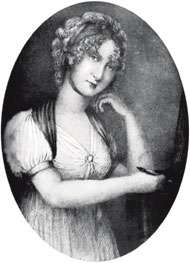Henriette-Lucy, Marquise de La Tour du Pin Gouvernet

Henriette-Lucy, Marquise de La Tour-du-Pin-Gouvernet (25 February 1770, Paris – 2 April 1853, Pisa), (also known as Lucie), was a French aristocrat famous for her posthumously published memoirs entitled Journal d'une femme de 50 ans.[1] The memoirs are a first-hand account of her life through the Ancien Régime, the French Revolution, and the Imperial court of Napoleon, ending in March 1815 with Napoleon's return from exile on Elba. Madame de la Tour du Pin, as she is frequently called, was a witness to the private lives of the royals, and her memoirs serve as unique testimony to much unchronicled history.
Family connections
Henriette-Lucy Dillon was born into a prominent Irish Wild Geese Jacobite military family in France. She was daughter of Arthur Dillon, colonel-proprietor of the Dillon Regiment, and his first spouse Therese-Lucy de Rothe (1751–1782). Her father had been born in England, so she was often regarded in France as English. However the family, of Norman descent, was linked to the Dillons of Costello-Gallen and the lords of Drumraney in Ireland, who were granted lands in County Westmeath in the thirteenth-century. Following her mother's death and her father's subsequent posting abroad, where he remarried, Lucie lived in the household of her grandmother, Mme. de Rothe, and Arthur Richard Dillon, Archbishop of Narbonne, until joining the Court of France. She married Frédéric, comte de Gouvernet, later Marquis de La Tour-du-Pin, an army officer and diplomat, in 1787. He was the son of Jean-Frédéric de la Tour du Pin-Gouvernet, a French Minister of War.
Early life
Following her mother she served as an apprentice lady-in-waiting to Marie Antoinette, Queen of France, from the age of 16. From the memoir a strong self-portrait emerges of a simple but straightforward woman of charm, heroism, and breeding.
During the French Revolution, many of her friends and family were executed and she fled Paris for the family estate of Le Bouilh, or Saint André Bouilh Cubzac in the Gironde region. From there, aged 24, she and her husband passed into exile for a new life on a dairy farm near Albany in Upstate New York. Although they were never officially listed as émigrés, Frédéric had been living in hiding prior to departure. She saw this time as the happiest of her life. She vividly describes the reality of owning slaves and interactions with the local Dutch families and the few remaining Native Americans of the area. She was close to Talleyrand during his exile in the United States, and she returned to France after the establishment of the Directorate, just like he did. She left the United States because her husband wanted to resume his career in public life and shore up the family fortunes. She was able to promote his career under Napoleon, who was looking for aristocrats to lend legitimacy to his court.
Later life
She continued to follow her husband to his various diplomatic appointments after the Bourbon Restoration. They went into effective exile after their son Aymar became involved in the anti-Orléanist plot of Caroline Ferdinande Louise, duchesse de Berry, in 1831, in the Vendée. Aymar escaped France, but was condemned to death in his absence. The family sold its possessions in France soon after. Following her husband's death in Lausanne in 1837, she moved to Italy, where she died in Pisa.
Legacy
Her memoir was written as a letter to her only surviving child after the age of fifty. It remained in the family and was not published until 1906.
She is the subject of a biography by Caroline Moorehead published in 2009.[2] Memoirs of Madame de La Tour-du-Pin translated by Felice Harcourt 1971 the McCall Publishing Company 230 Park Avenue, New York, N.Y. 10017.
- 70-122144
References
- ↑ Madame de la Tour du Pin (1999). Memoirs, laughing and dancing our way to the precipice. Harvill. ISBN 978-1-86046-548-2.
- ↑ Caroline Moorehead (2009). Dancing to the Precipice: The Life of Lucie de la Tour Du Pin, Eyewitness to an Era. HarperCollins. ISBN 978-0-06-168441-8.
Bibliography
Catherine Montfort (Spring 2015). "Madame de La Tour du Pin: An Aristocratic Farmer in America", New Perspectives on the Eighteenth Century, 12.1: 35-47.